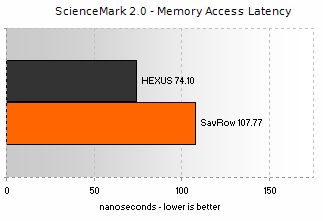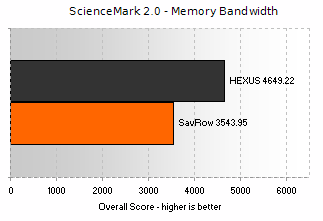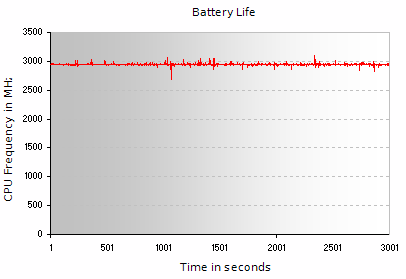Memory Subsystem Tests, CPU throttling and battery life
Memory Access Latency and Bandwidth
ScienceMark is used to measure the performance of the memory subsystem. We've seen comparatively lower performance from the SavRow system and the memory subsystem is the reason why.

The HEXUS reference desktop system, running its memory controller at the same speed and using the same timings for the memory, has 30% more memory bandwidth and a 30% faster access latency when going out to system memory. It's not entirely clear why the Intel i915P-based SavRow Katana 3D-9 performs as it does, with respect to the memory subsystem, especially as it's notably supplied with high-quality Corsair SODIMM RAM, but it clearly lags behind.
While the HEXUS desktop system uses different core logic, it's worth noting that even mainboards based on i915P are able to achieve similar numbers to those recorded using Intel i925XE on the HEXUS system. That the processors and memory modules are run at the same frequencies is all the more puzzling.
We discussed this significant delta in memory performance with SavRow's James Smith. Indeed highlighting the extremely high-level of expertise available to SavRow customers, he immediately suggested that perhaps desktop mainboard manufacturers are offering a similar proprietary performance enhancement in products sold with the Intel i915P chipset, as were made available in older products with i865 core logic.
HEXUS readers will remember than when Intel i865P ('Springdale') and the faster i875P ('Canterwood') were introduced to market, some manufacturers implemented a proprietary workaround for i865P to enable Intel 'PAT' (Performance Acceleration Technology), a feature which was only supported by Intel for i875P.
James suggested that perhaps third-party i915P desktop mainboards offer a similar kind of performance enhancement (over and above the features Intel officially support for i915P) but with its Intel i915P based notebook mainboard, Clevo's engineers didn't, or simply couldn't, find a way to enable a feature of this kind, and bring performance levels up to the equivalent of desktop implementations.
This makes some sense to us, as ASUSTeK for example offer its i915P based P5GD2 Premium mainboard with something it calls "Hyper Path2 - Shorten Memory Latency". It describes this as a 'technology' which "significantly shortens the latency time between the CPU and memory and improves memory performance without sacrificing stability."
In any event, something for SavRow to take to Clevo.
CPU throttling
Using Panopsys's essential monitoring tool, ThrottleWatch, I was able to observe no throttling at all over a sustained four-hour full-load period of heavy CPU activity, at full 3.6GHz clock speed. It seems the CPU cooler is very effective.Battery Life
While it's obvious the Katana is meant to be tethered to a power point as a desktop replacement unit, battery life still needs to be investigated.
As you can see, CPU frequency sits at around 2970MHz on battery power, the CPU bus clocking back to 166MHz from the default 200MHz. Battery life, running a combined set of 3DMark05 loops and a looped disk copy, was 50 minutes from a full charge.
As an aside, the external power brick gets hot, and I'm talking too hot to touch. There's a warning label on the power brick that says as much.









